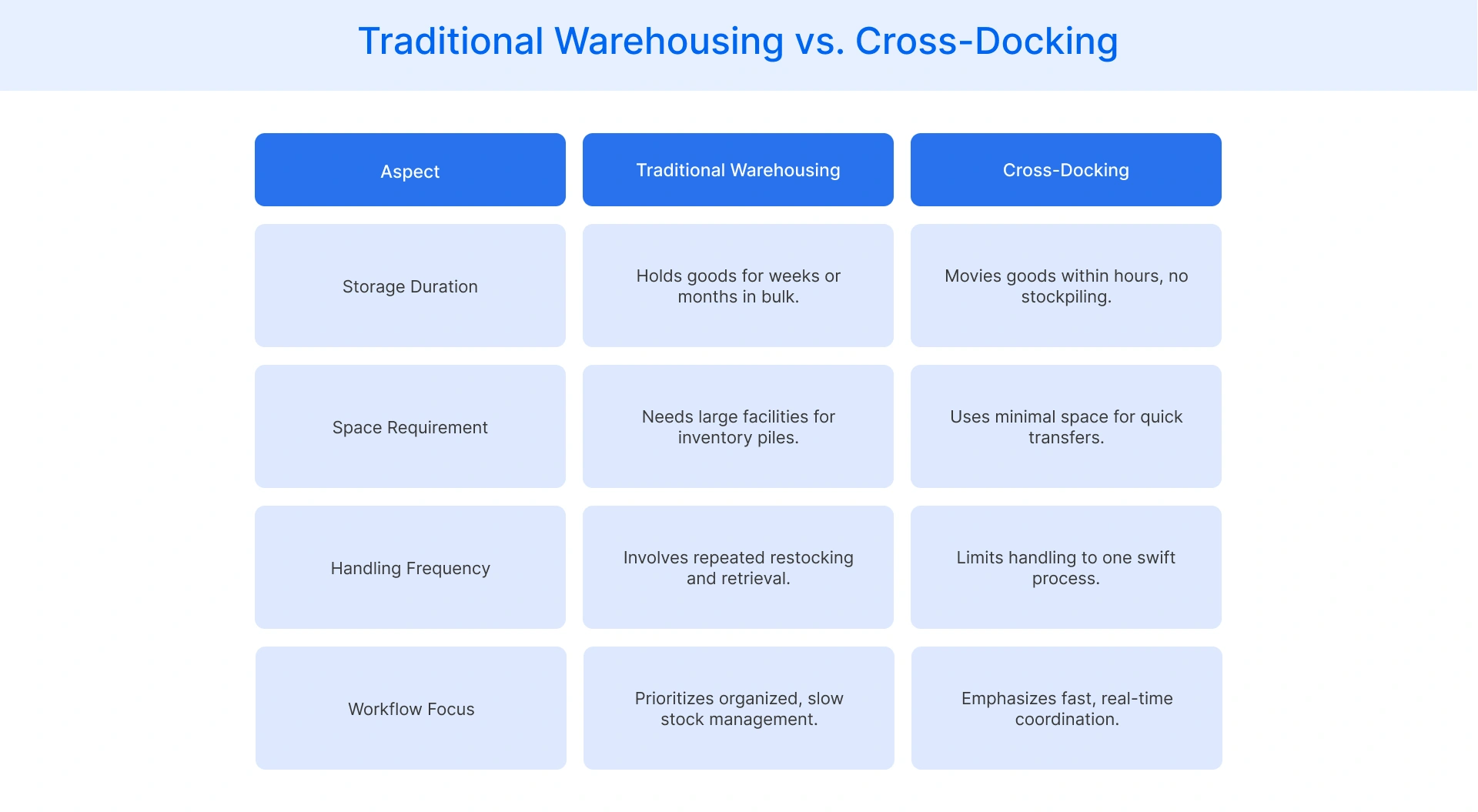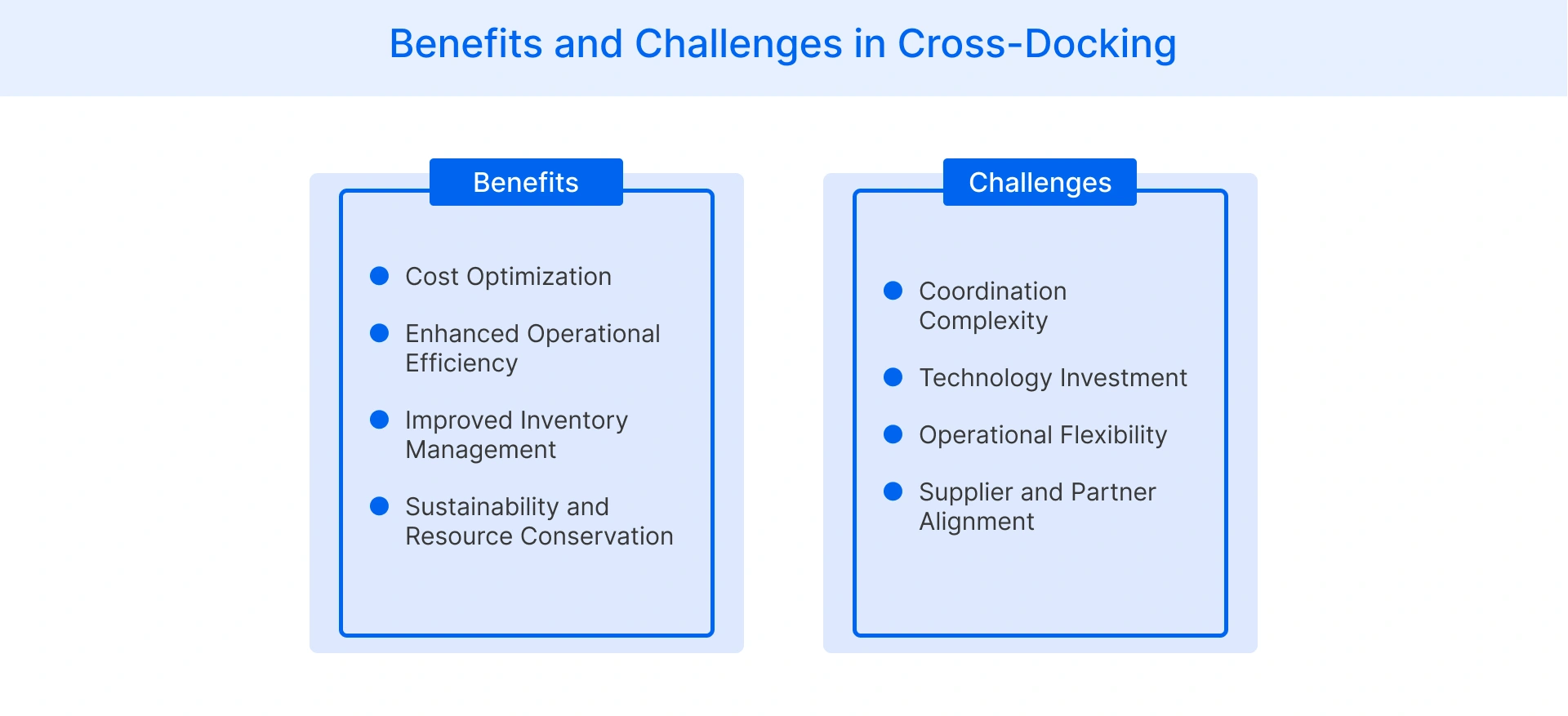Table of Contents
- What is Cross-Docking?
- Key Components of Cross-Docking
- Types of Cross-Docking
- Cross-Docking vs. Traditional Warehousing
- Steps to Implement Cross-Docking
- Benefits of Cross-Docking
- Challenges in Cross-Docking
- Conclusion
What is Cross-Docking?
Cross-docking is a streamlined supply chain process where inbound shipments are directly transferred to outbound transportation with minimal or no warehousing. This approach eliminates the need for long-term storage, reducing inventory holding costs and improving operational efficiency.
Unlike traditional warehousing, where goods are stored before being dispatched to their final destination, cross-docking focuses on immediate distribution. Products are received, sorted, and quickly loaded onto outbound vehicles, ensuring faster delivery and optimized logistics.
Industries such as retail, manufacturing, and e-commerce widely adopt cross-docking to enhance supply chain efficiency and effectively meet customer demand.
Key Components of Cross-Docking
Effective cross-docking operations rely on advanced infrastructure that enables efficient product transfer:
- Receiving Dock: This is where inbound shipments arrive and undergo initial checks for quality, accuracy, and damage. Efficient receiving docks prevent bottlenecks and facilitate quick processing.
- Sorting and Staging Areas: Goods are sorted based on destination, priority, or customer orders before being transferred to outbound transportation. Advanced scanning and automation improve accuracy and speed.
- Outbound Shipping Zones: These designated areas ensure that sorted products are loaded onto delivery vehicles in less time. Proper coordination at this stage minimizes delays and enhances supply chain efficiency.
- Warehouse Management System (WMS): A WMS integrates real-time tracking, barcode scanning, and automated routing to optimize cross-docking. It helps reduce errors and streamline operations.
- Skilled Personnel: Trained staff is essential to handle rapid product movement and maintain smooth operations. Their expertise ensures cross-docking runs seamlessly, meeting your retail demands effectively.
- Material Handling Equipment: Conveyor belts, forklifts, and automated guided vehicles (AGVs) facilitate the swift movement of goods between receiving, sorting, and outbound areas. Investing in efficient equipment reduces manual handling time.
Types of Cross-Docking
Cross-docking can be implemented in multiple ways, depending on the supply chain model and business requirements. The three primary cross docks focus on different sorting and distribution strategies.
Pre-Distribution Cross-Docking
In this technique, products are sorted and labeled for specific customers or destinations before arriving at the cross-docking facility. This method ensures that incoming shipments are ready for immediate transfer, reducing processing time at the distribution center. Retailers and manufacturers use pre-distribution cross-docking to optimize order accuracy and streamline deliveries, especially for high-demand or time-sensitive goods. Since sorting occurs at the supplier's end, the process requires strong coordination and accurate forecasting to avoid supply chain disruptions.
Post-Distribution Cross-Docking
It involves sorting products at the cross-docking facility based on real-time demand, customer orders, or regional distribution needs. Unlike pre-distribution, this approach allows businesses to be more flexible in allocating inventory, making it ideal for industries with fluctuating demand. Retailers dealing with seasonal trends or last-minute order modifications benefit from this model, as it enables more precise inventory management and reduces overstocking risks. However, efficient warehouse management systems are required to process and redirect goods swiftly.
Opportunistic Cross-Docking
This is a flexible approach in which incoming shipments are assessed upon arrival to determine whether immediate transfer is feasible. It is often used for back-ordered products, customer-specific shipments, or urgent deliveries. Businesses employing opportunistic cross-docking can capitalize on real-time demand fluctuations, reducing supply chain costs and inventory costs while maximizing distribution speed. However, successful implementation relies on robust supply chain coordination and well-integrated logistics systems to ensure operational efficiency.
Cross-Docking vs. Traditional Warehousing
Logistics strategies differ significantly between cross-docking and traditional warehousing, impacting efficiency and costs. Each method serves distinct purposes in retail supply chains, shaping operational outcomes.
Traditional warehousing methods focus on storing goods for extended periods in large facilities. It requires substantial space to hold inventory, increasing storage costs and labor costs for businesses over time. Workers handle products repeatedly, restocking shelves and retrieving items as orders come in slowly. This approach suits companies managing bulk stock or anticipating irregular demand fluctuations effectively.
On the other hand, cross-docking warehouse accelerates product movement, swiftly transferring goods from inbound to outbound vehicles. It minimizes storage, relying on real-time coordination to keep supply chains lean and responsive. Handling remains limited, cutting labor needs and speeding up delivery to retail endpoints.

Steps to Implement Cross-Docking
Successful cross-docking implementation requires a strategic approach that transforms traditional supply chain operations. Following these steps ensures smooth execution and maximized operational benefits.
Assess Your Supply Chain Needs
Businesses must conduct a thorough analysis of their current supply chain capabilities and operational requirements. They must evaluate product characteristics, shipping volumes, and existing distribution networks to determine cross-docking’s potential effectiveness. Factors such as product perishability, standardization, and frequency of shipments that make cross-docking particularly advantageous must also be considered.
Design the Facility Layout
Optimizing physical space is critical for efficient cross-docking operations. Develop a layout that minimizes product movement distances and creates clear, logical pathways for incoming and outgoing shipments. Ensure adequate space for sorting, staging, and rapid product transfer, with carefully planned receiving and shipping zones that support seamless logistics flow.
Implement Advanced Technology
Technology is the backbone of successful cross-docking implementations. Invest in sophisticated warehouse management systems that provide real-time tracking, inventory visibility, and precise coordination. Automated sorting equipment and advanced communication technologies enable businesses to streamline product transfer and minimize handling times.
Train Staff and Establish Procedures
Comprehensive staff training and standardized procedures are essential for cross-docking success. Develop detailed operational protocols that outline precise handling, sorting, and transfer processes. Invest in employee training programs that emphasize efficiency, accuracy, and the unique workflows associated with cross-docking methodologies.
Monitor and Optimize Performance
Continuous performance monitoring allows businesses to refine their cross-docking strategies. Implement key performance indicators that track efficiency, cost savings, and operational speed. Regularly assess and adjust processes to maximize the benefits of cross-docking implementation.
Benefits of Cross-Docking
The cross-docking facility offers various benefits for retail stores seeking to optimize their supply chain and logistics operations.
- Cost Optimization: Cross-docking dramatically reduces inventory holding expenses, requiring minimal storage space and eliminating unnecessary warehousing infrastructure. Organizations can redirect financial resources toward more strategic business initiatives and growth opportunities.
- Enhanced Operational Efficiency: The method enables businesses to accelerate product movement, reduce handling times, and streamline distribution processes. Companies can achieve faster order fulfillment, creating a more responsive and agile supply chain ecosystem.
- Improved Inventory Management: Cross-docking provides real-time visibility into product flow, allowing businesses to maintain leaner inventory levels. Organizations can respond more quickly to market demands and reduce the risks associated with excess stock.
- Sustainability and Resource Conservation: By reducing warehouse space requirements and minimizing product handling, cross-docking contributes to more environmentally friendly logistics operations. Businesses can lower their carbon footprint while improving overall operational efficiency.

Challenges in Cross-Docking
Implementing cross-docking requires careful consideration of the following operational and strategic considerations.
- Coordination Complexity: Cross-docking demands precise synchronization between suppliers, transportation providers, and distribution centers. Businesses must develop robust communication systems and establish intricate scheduling mechanisms to ensure seamless product transfer.
- Technology Investment: Successful implementation requires significant investment in advanced technological infrastructure. Businesses need sophisticated warehouse management systems, tracking technologies, and automated sorting equipment to support cross-docking operations.
- Operational Flexibility: Companies must develop highly adaptable operational processes that can quickly respond to unexpected logistical disruptions. Maintaining consistent performance requires continuous monitoring and rapid problem-solving capabilities.
- Supplier and Partner Alignment: Effective cross-docking necessitates close collaboration and alignment with multiple supply chain partners. Companies must establish clear protocols and develop strong, reliable relationships to ensure smooth product movement.
Conclusion
Cross-docking is a pivotal strategy in modern supply chain management. It enhances efficiency, reduces costs, and accelerates order fulfillment. By minimizing storage time and streamlining product flow, businesses can more effectively meet customer demands. At Flipkart Commerce Cloud (FCC), we offer advanced solutions to support such logistics strategies.
Our Digital Commerce Solution enables retailers to create seamless shopping experiences with customizable storefronts and efficient supply chain management. Additionally, our Pricing Solution provides real-time market insights and dynamic pricing tools to optimize profitability.
Integrating these technologies with cross-docking practices empowers businesses to achieve operational excellence and drive growth in the modern competitive marketplace.
FAQ
Cross-docking supports omnichannel retail by enabling faster distribution across multiple sales channels. It streamlines fulfillment for online and offline stores, reducing delivery times and improving inventory synchronization. This enhances customer satisfaction by ensuring quicker and more reliable product availability across purchasing platforms.
Cross-docking reduces handling stages, minimizing the risk of product damage. However, strict quality control at the receiving stage is required to ensure that defective or incorrect shipments are identified immediately. Implementing real-time tracking and inspection processes enhances product accuracy and maintains quality standards.
Small businesses can leverage cross-docking to reduce warehousing and transportation costs and accelerate order fulfillment. By optimizing supply chain processes, they can minimize storage needs and improve cash flow. However, successful implementation requires strong supplier coordination and efficient logistics.
Cross-docking significantly improves inventory turnover rates by reducing storage time and enabling faster product movement. Since consumer goods are directly transferred to outbound shipments, they spend minimal time in warehouses, reducing excess stock and improving cash flow.

